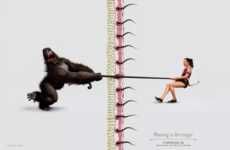
This Diagram Chronicles Iconic English Style Through the Ages
Charlotte Joyce Kidd — October 7, 2015 — World
References: visual.ly & designtaxi
This British fashion history infographic is a beautifully illustrated timeline of the evolution of English style.
The '100 Years of Iconic British Style' diagram separates the distinct looks of British fashion by decade, spanning the entire 21st century. It starts in the 1900s to 1910s, when men wore double-breasted suits accessorized with pocket watches and ascots and women covered up in full-length dresses. It travels through the fashion history of each decade, including the iconic flapper style of the 1920s and the clothing revolution in the 1970s up to the fedoras and chain belts of the early 2000s. In each decade, it uses a specific piece to highlight the era -- for example, a Christian Dior dance dress for the 50s.
This Iconic British Style infographic is an educational and gripping guide to British fashion history.
The '100 Years of Iconic British Style' diagram separates the distinct looks of British fashion by decade, spanning the entire 21st century. It starts in the 1900s to 1910s, when men wore double-breasted suits accessorized with pocket watches and ascots and women covered up in full-length dresses. It travels through the fashion history of each decade, including the iconic flapper style of the 1920s and the clothing revolution in the 1970s up to the fedoras and chain belts of the early 2000s. In each decade, it uses a specific piece to highlight the era -- for example, a Christian Dior dance dress for the 50s.
This Iconic British Style infographic is an educational and gripping guide to British fashion history.
Trend Themes
1. Sustainable Fashion - As fashion evolves through the decades, sustainable fashion practices become increasingly important in minimizing the industry's impact on the environment.
2. Retro and Vintage Styles - Nostalgic fashion trends from past decades have the potential to make a comeback among consumers looking for unique and timeless styles.
3. Gender-neutral Fashion - The evolution of British fashion history showcases changes in gender roles and stereotypes, providing the opportunity for designers to create more inclusive fashion options for all genders.
Industry Implications
1. Fashion Retail - Retailers can use this British fashion history chart to curate product offerings that reflect the styles and trends of different decades while staying relevant to modern consumer preferences.
2. Fashion Education - Educators in fashion can use this infographic to inspire curriculum development and teach students about the influence of history on current and future fashion design.
3. Fashion Design and Manufacturing - Fashion designers and manufacturers can use this historical chart as inspiration for designing unique and innovative styles that incorporate elements of past fashion trends with modern materials and production techniques.
4.8
Score
Popularity
Activity
Freshness























